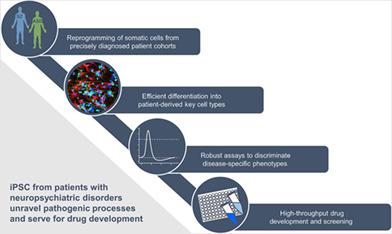当前位置:
X-MOL 学术
›
Stem Cells Transl. Med.
›
论文详情
Our official English website, www.x-mol.net, welcomes your
feedback! (Note: you will need to create a separate account there.)
The potential of induced pluripotent stem cells for discriminating neurodevelopmental disorders.
STEM CELLS Translational Medicine ( IF 5.4 ) Pub Date : 2020-08-31 , DOI: 10.1002/sctm.20-0206 Ricarda Stock 1 , Pauline Jeckel 1 , Udo Kraushaar 1 , Richard Wüst 2 , Andreas Fallgatter 2 , Hansjürgen Volkmer 1
STEM CELLS Translational Medicine ( IF 5.4 ) Pub Date : 2020-08-31 , DOI: 10.1002/sctm.20-0206 Ricarda Stock 1 , Pauline Jeckel 1 , Udo Kraushaar 1 , Richard Wüst 2 , Andreas Fallgatter 2 , Hansjürgen Volkmer 1
Affiliation

|
Studying human disease‐specific processes and mechanisms in vitro is limited by a lack of valid human test systems. Induced pluripotent stem cells (iPSCs) evolve as an important and promising tool to better understand the molecular pathology of neurodevelopmental disorders. Patient‐derived iPSCs enable analysis of unique disease mechanisms and may also serve for preclinical drug development. Here, we review the current knowledge on iPSC models for schizophrenia and autism spectrum disorders with emphasis on the discrimination between them. It appears that transcriptomic analyses and functional read‐outs are the most promising approaches to uncover specific disease mechanisms in vitro.
中文翻译:

诱导多能干细胞识别神经发育障碍的潜力。
由于缺乏有效的人体测试系统,在体外研究人类疾病特异性过程和机制受到限制。诱导多能干细胞 (iPSC) 发展成为一种重要且有前途的工具,可以更好地了解神经发育障碍的分子病理学。源自患者的 iPSC 能够分析独特的疾病机制,也可用于临床前药物开发。在这里,我们回顾了当前关于精神分裂症和自闭症谱系障碍的 iPSC 模型的知识,重点是它们之间的区别。似乎转录组分析和功能读出是在体外揭示特定疾病机制的最有希望的方法。
更新日期:2020-08-31
中文翻译:

诱导多能干细胞识别神经发育障碍的潜力。
由于缺乏有效的人体测试系统,在体外研究人类疾病特异性过程和机制受到限制。诱导多能干细胞 (iPSC) 发展成为一种重要且有前途的工具,可以更好地了解神经发育障碍的分子病理学。源自患者的 iPSC 能够分析独特的疾病机制,也可用于临床前药物开发。在这里,我们回顾了当前关于精神分裂症和自闭症谱系障碍的 iPSC 模型的知识,重点是它们之间的区别。似乎转录组分析和功能读出是在体外揭示特定疾病机制的最有希望的方法。











































 京公网安备 11010802027423号
京公网安备 11010802027423号